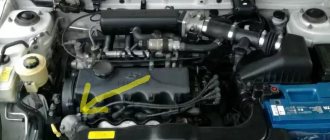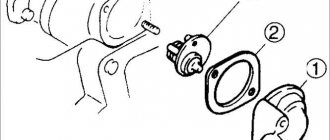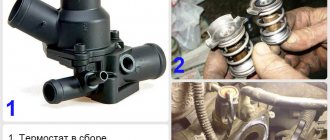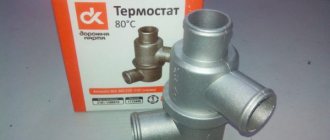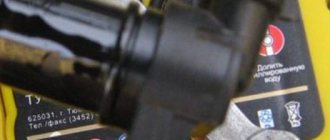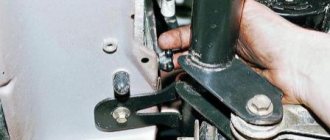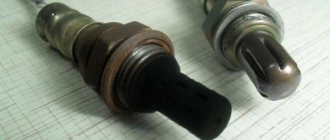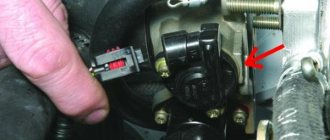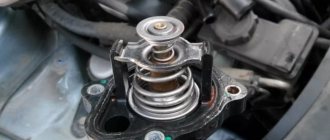Failure of this unit inevitably leads to a number of problems - overheating of the motor or the inability of it to reach the desired temperature.
That's why a car enthusiast needs to know how to check the thermostat and what malfunctions of this device exist.
Common causes of breakdowns; Ways to solve problems; We check the device without removal and with dismantling; Features of testing on VAZ cars; We check the device upon purchase; Let's summarize.
Common reasons for device failure
During the operation of the car, the following thermostat breakdowns and the reasons for their occurrence are possible.
1. Increased heating time of the power unit.
The motor operates unstably (for example, it trips), which leads to excessive fluctuations of the thermostat valve and damage to its seat. Due to exposure to strong vibration, damage to the temperature-sensitive element occurs.
The result is that coolant gets inside the unit (wax comes out), which leads to a malfunction of the device, which stops opening or closing the valve when the required temperature level is reached.
The cause of such a breakdown may be the ingress of coolant into a special element that controls the temperature level of antifreeze in the system.
The result is an increase in the total volume of the filler and premature opening of the valve.
3. The thermostat opens with a delay.
The reason is the appearance of a leak of a special filler that allows the device to respond to temperature changes.
Changing the volume of this element downwards will require more heating to open the valve.
The result is that the thermostat operates with a certain time delay.
4. The engine regularly overheats.
For example, situations are possible when the thermostat allows coolant to pass through on time, but the engine still reaches a high temperature.
The reason is that the fluid is not passing through the main radiator, but is being discharged through the return line back into the engine.
5. The thermostat valve is not fully open due to mechanical damage.
The result is a small volume of liquid entering the radiator to completely reduce the temperature in the system.
6. The valve is not fully closed.
This is possible when coolant “sneaks” into the working element.
Due to the increase in the volume of the working element, the valve disc cannot close completely.
7. Incorrect operation of the device.
For example, opening and closing it ahead of time. This is possible in case of failures in the factory settings and excessive overheating of the cooling system of the power unit.
8. Destruction of the rubber seal.
Due to a breakdown, oil gets into the coolant. The latter acts as a solvent for the rubber valve seal (rubber simply cannot withstand the impact).
Possible solutions to the problem include:
1. If the coolant temperature exceeds the norm (provided the thermostat is working and it is correctly selected), it is necessary to replace the device, but with a higher opening temperature. As a rule, this step is recommended for motorists who operate cars in the mountains and in regions with high average annual temperatures.
3. Early opening of the thermostat is possible due to excessive pressure in the system. Zones of different pressure often appear around the device, which leads to early operation of the valve. There are several reasons:
failure of the cooling system; The thermostat spring has weakened; The engine runs at higher speeds during the warm-up period. 4. The engine takes too long to warm up.
incomplete closing of the thermostat valve; violation of the integrity of the valve plate (for example, a gap has appeared); Incorrect thermostat position (possibly changing the location of the air valve). 5. The engine heats up above normal even in a situation where the thermostat is fully open:
traffic jams or low coolant level; failure of the radiator (clogging of its cells); failure of the cooling pump or fan; contamination of the cooling system.
The problems described above can appear at any time. To avoid engine overheating and damage, you need to know how to check the thermostat directly on the car and after dismantling it at home.
It is important to know that after starting the engine, the thermostat valve is still closed and the coolant flows through a small circuit (through the engine and the stove). This allows the power unit to quickly reach the desired temperature.
As soon as the required level is reached, the valve opens and coolant flows through the main radiator.
Understanding this principle is very important when checking the thermostat.
Therefore, we invite you to familiarize yourself with the diagram.
1. Without dismantling the device.
The easiest way is not to remove the device, but to check it directly on the car. The main condition is a cold engine.
The diagnostic process begins with starting the power unit and warming it up for 2-3 minutes at idle.
This time is not enough for the engine to warm up and the coolant to circulate in a large circle, so the radiator is not yet connected to the general engine cooling system.
To check that the system is working correctly, touch the pipe that goes to the top of the main radiator with your hand.
The pipe should be cold, which signals the passage of coolant in a small circle (only through the engine and stove).
Design Features
A thermostat is a small mechanical valve. The device regulates and determines the temperature of the coolant in the engine system and is responsible for the quality of warming up the car engine. The structure consists of the following elements:
- frame;
- inlet pipe. Connects directly to the cooling system;
- wax ball;
- main valve Responsible for blocking the main circulation process;
- piston;
The thermostat regulates the temperature of the coolant in the engine
- bypass valve. If necessary, closes the small cooling circle;
- special spring to hold the portable valve;
- outlet pipe. Connects to a pump pumping cooled liquid;
- a spring holding the bypass valve;
- additional inlet pipe. The element is connected to the radiator.
This video will help you get acquainted with the principle of operation of the thermostat:
Types of modern thermostats
Today, car manufacturers equip engines with different thermostats. There are several main types of these useful structures:
- Electronically controlled device. Suitable for all operating modes of the power unit. Electronic devices are supplemented with a special heating resistance. Known for their efficiency and accuracy. Their use allows to reduce fuel consumption.
- Single valve. Reliable and durable unit. The majority of cars are equipped with a single-valve thermostat.
There are several main types of car thermostats
Two-valve. One thermostat has two valves: the main and the secondary. The main one is used to circulate antifreeze in a large circle. The second, the so-called bypass valve, performs similar actions, only in a smaller circle. Two-valve thermostats are in demand in the CIS.
Two-stage. The design also provides two valves: large and small. It is recommended to install in a system with high coolant pressure.
It will be useful: What changes await motorists this year
Signs and causes of failure
Any malfunctions in the operation of the device have a detrimental effect on the operation of the entire vehicle. The main symptom and cause of the malfunction is considered to be corrosion. It gradually corrodes the locking pin and cylinder. A sign of a broken thermostat in this case is a pulsating, continuous flow of cooled liquid.
It does not matter what position the valve is in. Signs of a faulty thermostat also include:
- The lower pipe becomes warm within a few minutes of operation of the unit. The device is always open.
- The car engine quickly overheats. When a car engine overheats, the design pipes (lower and upper) are at the same temperature.
A faulty thermostat is indicated by engine overheating and several other indicators.
While the device is operating, the engine needle drops sharply and shows a temperature lower than normal. When the engine stops running, the needle reading increases. Staying in a closed position for a long time. In this case, the structure literally jams. The temperature on the instrument panel shows that it is boiling. After prolonged operation of the engine, the lower pipe remains cold.
Due to breakdowns, the car cannot start normally. You should understand why the thermostat is not working and find out the signs of unit failure as soon as possible. Violation of the temperature regime has a detrimental effect on the engine: it quickly wears out and becomes unusable.
Bottom line
Thus, replacing the VAZ 2114 thermostat yourself allows you to save time and costs for car service services.
Have a safe journey and ensure proper operation of all components of your car!
- Next Faw Besturn X80: price and equipment of a chic oriental guest
- Back Frame SUVs 2021: who we will remember
- Engine/Ratings
Aug 23, 2019
- Hyundai crossovers / News
Aug 23, 2019
- Aug 22, 2019
- Volkswagen crossovers / News
Aug 21, 2019
- Crossovers Ford / News
Aug 20, 2019
- Audi crossovers / News
Aug 20, 2019
- April 13, 2019
- March 12, 2019
- Feb 17, 2019
- April 11, 2019
- July 27, 2017
Recommendations and tips
Often, costly breakdowns occur as a result of improper operation of equipment. Let's look at some tips from experts that will extend the life of the unit.
If due to negligence the refrigerator was turned off, do not rush to turn it on, you need to wait a while and then start it up. After defrosting, you need to give the chambers time to cool and then load the food. To ensure careful operation of the engine, you should not set the maximum temperature; it is enough to set the knob to the middle for the unit to operate efficiently. Do not block the evaporator with products; disruption of its operation will lead to more global breakdowns. It is forbidden to chip off ice during defrosting. For a faster process, it is better to use warm water. It is worth storing light foods in the refrigerator door to protect the rubber seal from wear. Install the refrigeration unit away from heating appliances. If the unit breaks down, contact a specialist. By following all the recommendations of the specialist, you can avoid problems with the breakdown of the refrigerator.
So, you can find out the reason for the malfunction of the thermostat in the refrigerator yourself, while having only basic knowledge and understanding of the refrigerator’s structure. But if a malfunction is detected, it is better to contact a technician who is guaranteed to fix the problem without harm to other parts.
Why do sensors in refrigerators break?
There are not many reasons why thermal detectors fail. The main thing is its natural wear and tear - any part eventually exhausts its reserves and needs to be replaced.
A refrigerator temperature sensor is not very expensive. Someone might try to argue with this, saying that for such and such a refrigerator, this device costs a lot of money! Let me object - replacing a temperature detector, which costs that “a lot of money,” will, in any case, cost you less than buying a new refrigerator. It is much more profitable to recognize the breakdown of the analyzer in time and replace it, even for 2, 3, 4 thousand, than to let this moment take its course and subsequently shell out ten thousand to replace the compressor or even more to buy a new refrigerator.
So, before you question the claim that thermal sensors are inexpensive, check how much you will have to pay if a broken detector causes other systems to fail.
Another reason may be a voltage drop in the operating network. Like any other electrical appliance, a temperature sensor can burn out if the wiring in the apartment is poor or there are network malfunctions, and the sockets in the room are not very good.
There are other reasons, but they are not so frequent and therefore you can not focus on them (mechanical damage, manufacturing defects, etc.)
Thermostat VAZ 2113 – 2114 – do-it-yourself check and replacement
The thermostat on cars VAZ 2113 VAZ 2114 is an element of the cooling system that discharges coolant to a large circle at a certain temperature.
The thermostat ensures that the engine runs correctly and does not get too hot. It is also responsible for warming up: if the thermostat is worn out and the fluid immediately comes out in a large circle, then the car takes a very long time to heat up (especially in winter), which means the car’s fuel consumption increases.
Over time, a lot more problems will emerge, because running the engine for a long time on a cold engine is very destructive, and driving on a cold engine is even worse. There is a lot of load on the engine, lubricant does not reach all parts well, etc.
If possible, in very cold weather (-25 and above, although -20 is already enough), we recommend not using the car at all if you want the engine to live a long enough life and not require major repairs in the near future.
How it works?
Any engine uses two circuits:
- Small.
- Big.
Both contain coolant. However, after the engine starts, it heats up only in a “small” circle. This way the motor will quickly reach its operating temperature, which, as is known, is 80-90 degrees Celsius. The small circle is the heat exchanger of the stove and the engine itself. The second circuit includes a radiator with pipes, which has a large cooling area. This radiator is located in front of the engine. Additionally, air intake is provided by a special impeller. This could be a viscous coupling or an electric fan. But the operation of these elements no longer depends on the thermostat (the temperature sensor or the crankshaft drive belt is used here).
coolant temperature
As you can see, the device has a simple operating principle. However, this mechanism sometimes fails. Signs of a malfunctioning thermostat installed on a Renault Logan are always accompanied by overheating. But first things first. So, below we will look at the main symptoms and signs of a thermostat malfunction.
Logan 1.6 has a copper thermostat. Its service life is quite long (10 years or more). But if it malfunctions, do not hesitate to replace it.
Where is the thermostat located on the VAZ 2113
On injection models of the VAZ 2113, the thermostat is located under the air filter housing, on carburetor models it is located in the same place, however, the housing is moved to a slightly different place, so on the carburetor you do not need to bother and remove the housing, but simply throw off the high-voltage wires and get to work. In any case, do not be alarmed, the housing can be removed quickly and easily, read the article: “Replacing the air filter housing on VAZ cars.” After removing the housing, you will see the thermostat with the naked eye (indicated by a red arrow in the photo below), and next to it there is a battery (indicated by a blue arrow). We hope we have clearly explained the location of the thermostat and you can easily find it.
Design Features
A thermostat is a small mechanical valve. The device regulates and determines the temperature of the coolant in the engine system and is responsible for the quality of warming up the car engine. The structure consists of the following elements:
- frame;
- inlet pipe. Connects directly to the cooling system;
- wax ball;
- main valve Responsible for blocking the main circulation process;
- piston;
The thermostat regulates the temperature of the coolant in the engine
- bypass valve. If necessary, closes the small cooling circle;
- special spring to hold the portable valve;
- outlet pipe. Connects to a pump pumping cooled liquid;
- a spring holding the bypass valve;
- additional inlet pipe. The element is connected to the radiator.
Read also: thermostat device in a car.
This video will help you get acquainted with the principle of operation of the thermostat:
Types of modern thermostats
Today, car manufacturers equip engines with different thermostats. There are several main types of these useful structures:
- Electronically controlled device. Suitable for all operating modes of the power unit. Electronic devices are supplemented with a special heating resistance. Known for their efficiency and accuracy. Their use allows to reduce fuel consumption.
- Single valve. Reliable and durable unit. The majority of cars are equipped with a single-valve thermostat.
- Two-valve. One thermostat has two valves: the main and the secondary. The main one is used to circulate antifreeze in a large circle. The second, the so-called bypass valve, performs similar actions, only in a smaller circle. Two-valve thermostats are in demand in the CIS.
- Two-stage. The design also provides two valves: large and small. It is recommended to install in a system with high coolant pressure.
Signs and causes of failure
Any malfunctions in the operation of the device have a detrimental effect on the operation of the entire vehicle. The main symptom and cause of the malfunction is considered to be corrosion. It gradually corrodes the locking pin and cylinder. A sign of a broken thermostat in this case is a pulsating, continuous flow of cooled liquid.
It does not matter what position the valve is in. Signs of a faulty thermostat also include:
- The lower pipe becomes warm within a few minutes of operation of the unit. The device is always open.
- The car engine quickly overheats. When a car engine overheats, the design pipes (lower and upper) are at the same temperature.
- While the device is operating, the engine needle drops sharply and shows a temperature lower than normal. When the engine stops running, the needle reading increases.
- Staying in a closed position for a long time. In this case, the structure literally jams. The temperature on the instrument panel shows that it is boiling. After prolonged operation of the engine, the lower pipe remains cold.
Due to breakdowns, the car cannot start normally. You should understand why the thermostat is not working and find out the signs of unit failure as soon as possible. Violation of the temperature regime has a detrimental effect on the engine: it quickly wears out and becomes unusable.
Ways to check an element
You can check the operation of the thermostat yourself directly in the car. In the vast majority of cases, such diagnostics give reliable results. You need to start checking when the engine has completely cooled down: start it and periodically feel the lower part of the radiator and the pipe extending from the bottom back to the engine.
The serviceability of the thermostat is determined by the following signs:
- at the initial stage of warming up, the radiator and the pipes suitable for it are completely cold;
- at an antifreeze temperature of 40–60 °C, the upper supply hose begins to warm up, the lower one remains cold;
- when the antifreeze heats up to 90–95 °C, the entire area of the heat exchanger and the lower pipe become hot, which indicates the opening of the damper and the movement of liquid along a large circuit.
It is recommended to carry out diagnostics until the sensor is triggered and the fan automatically turns on.
Deviations from the norm are interpreted as follows:
- If the inlet and outlet pipes together with the radiator immediately warm up, the thermostat is stuck in the open position. Antifreeze initially flows in a large circle, hence the heating.
- When the temperature reaches 90 °C, the bottom of the heat exchanger and the outgoing hose remain cold - the thermoelement damper is tightly closed, the part has become unusable.
- When the top of the radiator is hot and the bottom is slightly warm, the thermostat is stuck half-closed.
Unlike the first two points, the last conclusion requires mandatory confirmation. It is quite difficult to make a clear diagnosis when the coolant is divided into two streams moving along different circuits. Uneven heating of the heat exchanger fins, turning on of the fan and temperature surges are indirect signs. Symptoms of an air lock in the cooling system appear similarly.
To clearly check the functionality of the thermostat, it will have to be removed from the car. Disassembly and diagnostics are performed in the following order:
- Let the engine cool and drain the antifreeze - first from the cylinder block, then from the radiator. It is more convenient to empty the system into a wide container with low sides.
- Loosen the clamps securing the pipes to the thermostat. Disable them and remove the element.
- Inspect the part for a slightly open damper. If a malfunction is detected, further checking is pointless - you need to buy and install a new spare part.
- Heat a pan of water on the stove. When its temperature approaches boiling, lower the thermostat into the container and watch the damper. It should open without delay.
- Remove the part from the pan. When cooled, the thermoelement should immediately close the passage.
Reminder. After draining the cooling system, immediately disconnect the throttle body heating pipe. When you start pouring antifreeze back in, air will escape through the removed hose.
If during the inspection it turns out that the damper does not work or is jammed, the part must be replaced, since it cannot be repaired. Considering the large number of fakes on the auto parts market, you can first test a new thermostat in a store. Close the outlet pipe with your finger and try to blow air through the inlet pipe. A hermetically sealed damper will prevent this from happening.
Retest the new part at home by immersing it in a pan of boiling water. If the heat-sensitive mechanism does not work, return the defective part to the store or exchange it for another one.
Replacing the thermostat VAZ 2113 – step-by-step instructions + photo report
In order to replace the thermostat on a VAZ 2113, you must perform the following procedure:
- The first step is to drain the coolant.
- Removing the air filter
- Loosen the 4 clamps securing the thermostat hoses.
- Disconnect the hoses from the thermostat pipes and remove the thermostat.
- To check the operation of the thermostat, place it in almost boiling water. In water, the main thermostat valve should open.
- Reinstall the thermostat in reverse order. After installation, check the connections for leaks.
Well, all the work on replacing the thermostat on the VAZ 2113 has been completed. We recommend that you watch a video on the topic.
How to check the thermostat without removing it from the car? Signs of a bad thermostat
The thermostat is a small part in the mechanism of an internal combustion engine that is responsible for the operation of the cooling system. When this component stops working, thick accumulations of steam begin to emerge from under the hood of the vehicle, a similar picture can often be seen in various films and TV series.
The thermostat mechanically transfers flows of cooled liquid at different temperatures through the cooling system. It works in a large circle when the engine overheats - passing through the radiator, and in a small circle when the engine is cold - bypassing it. If this part does not work correctly, then in the cold season the stove freezes and it is impossible to warm up the car interior. There is a thermostat in both a used car and a new one, if they use a closed version of the liquid cooling system with forced circulation of liquid at a low temperature. The principle of operation of the part is identical for all cars, regardless of the country of manufacture.
Thermostat operating principle
Its main component is a mechanical valve, which begins to work under the influence of a clear mechanism. The hermetically sealed body of the device contains a special heat-sensitive wax, which, under the influence of high temperatures, begins to melt and increase in volume, thereby squeezing the rubber chamber. In turn, the chamber begins to push out a chrome-plated metal rod, which operates the valves.
When the engine starts, the thermostat remains closed so that antifreeze cannot get into the radiator and cool down. During this period of time, it moves along a small circle of the cooling system and cools the heating engine. When the liquid temperature reaches 90 °C, the engine has accelerated to the required mode; if it is above 90 °C, it will begin to overheat, so the antifreeze needs to get rid of the heat and it goes into high gear.
This principle of operation is very simple, but when the integrity of the structure is not respected, the wax can leak out due to the use of low-quality antifreeze (antifreeze) or corrosion processes, which will lead to an increase in the friction force of the moving rod.
Antifreeze foaming
The coolant may bubble in the expansion tank and foam without increasing the temperature . It remains cold, but a cap of white foam forms on the surface.
There can be several reasons for foaming:
- low quality coolant;
- mixing different brands of liquid;
- using antifreeze that is not recommended by the car manufacturer;
- damage to the cylinder block gasket.
In the first 3 cases, fixing the problems is quite simple: drain the old fluid, flush the system and fill in new antifreeze, which is suitable in all respects.
In the latter case, wear of the gasket leads to air entering the cylinder block. Tiny air bubbles form, which enter the cooling system and form foam. If such a problem is noticed, you cannot do without replacing the damaged gasket. Damage can be determined by carefully inspecting the cylinder head. If there are traces of oil on it, then it is clearly worn out.
When to change: signs of thermal switch failure
Abstract symptoms can indicate the nature of the disease that has befallen the thermostat:
Stuck in open position (coolant constantly circulates through radiator)
In cold weather, the engine does not heat up well, and at extreme city speeds the coolant temperature drops. Let's say it's -15°C outside, the coolant at idle has warmed up to 70°C, we're driving on a multi-lane road, moving at a speed of 60 km/h, and the temperature gauge needle is either standing still or going down.
Fuel consumption increases noticeably (+ 1-2 liters per 100 km). The wedge is in the closed position (antifreeze moves along the jacket and heater radiator, bypassing the main heat exchanger). There will be no cooling and overheating is inevitable in summer. The fact is clearly clarified by the thermometer needle running upward when the cooling fan is on. Additionally, the “brains” indicate a problem in the form of an illuminated Check Engine icon. Final stop at an intermediate position. Prolonged heating + overheating in hot weather. Slight increase in appetite (within 1 l/100 km).
It is impossible to close a large circle tightly, while the rod moves and the full opening occurs. There is no wedge. This is prevented by deposits accumulated as a result of untimely change of antifreeze, mixing coolant of different classes (for example, on a Hyundai Solaris, antifreeze can only be mixed with G11), and the use of cheap or counterfeit fluids. The fact can be revealed in warm weather only through tubes. In winter, pollution will be indicated by a reluctant rise in temperature from 70°C to 90-95°C when driving on the highway, but in the city there will be no problems with warming up. Seeing such a picture, those who like to cover the radiator grille with cardboard often persuade the owner to insulate the front end. This is definitely useful in cold weather.
